
16/8 Intermittent Fasting Benefits When Combined with Sauna Detoxification to Restore Health
Fasting is a tradition that many cultures and religions have been practising for thousands of years, but it also offers a range of health benefits for those looking for a way to quickly detoxify their bodies and restore health.
There are many ways to improve health and fitness, and combining them can often improve your health much faster than using just one system. Saunas offer amazing health benefits, and when you safely combine their health advantages with the 16/8 intermittent fasting benefits, you can achieve an optimal state of health much faster.
Keep reading to learn more about the 16/8 intermittent fasting method, its many health benefits, and how regular sauna sessions can help.
What is Fasting?
Fasting is a form of abstinence from food or drink. The word “fasting” is often used when referring to a religious practise, but it can also be used as a part of a diet plan. Fasting has been practised for centuries, and there are many different types of fasting strategies. Some people fast for spiritual reasons, while others do it for health benefits.
What is the 16/8 Intermittent Fasting Method?
The 16/8 Intermittent Fasting (IF) method is currently one of the fastest growing health trends, with many studies showing how effective it is at improving health. A 16/8 intermittent fasting plan does not focus on what you eat. Instead, it dictates when you can eat.
This makes it more of an eating pattern than a diet, but intermittent fasting is not new. People have been using various fasting ratios to dictate their eating patterns for a while now. One method involves fasting for 24 hours one day a week (going from dinner to dinner). The 5:2 diet is another popular fasting strategy that involves eating a total of just 500 - 600 calories on two consecutive days of the week.
The 16/8 Intermittent Fasting system, also referred to as the Leangains protocol, restricts daily eating to an 8-hour period, and then fasting for 16 hours until the next cycle. You might restrict your mealtimes to between 1 p.m. and 9 p.m. on each fasting day, which is 8 hours, and then fast for 16 hours until 1 pm the next day. The eating window is arbitrary and can be any 8-hour window you choose. Some people choose to eat between 8 a.m. and 4 p.m. to avoid skipping breakfast on a busy workday.
The IF method has grown popular because its ratio of eating to fasting is easy to maintain and sustain compared to other systems. If you don't compensate with extra calories during your allotted eating hours, intermittent fasting has been shown as an effective strategy for losing weight and improving health.
Health Benefits of Intermittent Fasting
Intermittent Fasting (IF), also known as Time Restricted Eating (TRE), gained popularity in the 1990’s when a group of University of California, Los Angeles researchers observed that their subjects, when confined to a 10-hour eating window, lost fat and gained lean body mass. [source] Since then, researchers have found that intermittent fasting may:
- Help your body with inflammation
- Increase growth hormone
- Improve fat loss
- Improve insulin sensitivity
- Reduce blood pressure
- Increase longevity
- Delay the ageing process
- Increase fertility
- Lower blood glucose
- Improve cardiovascular health
- Improve brain function
- Suppress appetite
- Reduce oxidative stress
- Decrease the risk of cancer
How Does the Intermittent Fasting Diet Work?
The intermittent fasting diet is a weight loss strategy that involves alternating between periods of fasting and eating. During the fasting periods, you consume only water or other calorie-free beverages.
The eating periods vary in length but typically last for 8 hours or more. This diet plan can help you lose weight by creating a calorie deficit. When you fast, your body is forced to burn stored calories for energy. Intermittent fasting can also improve other health conditions, like improving your metabolism and increasing your insulin sensitivity.
How to Use the 16/8 Intermittent Fasting Method
Start 16/8 fasting by selecting an 8-hour window when you will be allowed to eat. Some of the most common 16/8-time allotments include:
- 7 a.m. to 3 p.m.
- 9 a.m. to 5 p.m.
- 12 p.m. to 8 p.m.
- 2 p.m. to 10 p.m.
The most popular choice is between noon to 8 p.m., because you only fast overnight. You are required to skip breakfast but can easily make up for it with a nutritious lunch and dinner. Your meal plan should give you the opportunity to indulge in a few healthy snacks along the way.
If skipping breakfast does not sound appealing, you can use the 9 to 5 window to allow time for a healthy breakfast at 9 a.m. and a regular lunch at the normal time. However, this strategy may conflict with workers who are on the clock between 9 and 5.
Strict schedules for eating can be hard to stick to if you get busy and forget. Setting an alarm can help, as can preparing your meals beforehand.
Using a Sauna with Intermittent Fasting
People are becoming more aware of the health benefits of using a sauna but wonder whether it is safe to use while fasting.
Yes, using a sauna in conjunction with the 16/8 Intermittent Fasting method is safe, but you do need to follow parameters to ensure you don't put yourself at risk.
More research is needed to continue learning about how saunas improve health, but the results we have so far are promising. For example, a study conducted in 2018 over seven sauna sessions revealed an 18% reduction in fasting blood glucose levels in participants on average. These results indicate that using a sauna on an empty stomach may help reduce the onset of chronic diseases like diabetes and other underlying health conditions.
How to Use Saunas with the 16/8 Intermittent Fasting Method
Intermittent fasting is an excellent way to improve your health, but it depends on the type of fasting you do as to what types of saunas are safe to use.
Some fasting methods require people not to have food or drink during the fasting phase, so excessive sweating in a sauna could be problematic if you can’t replace the fluids you have lost.
A portable sauna for home that uses steam will reduce the amount of moisture you lose through sweating. Temperatures are also not as high in steam saunas as they are in traditional saunas, but you should still limit your time to 10-to-15-minutes if you are not taking fluids.
The type of sauna you use during 16/8 intermittent fasting is not as critical, so user preference applies. Portable steam saunas and sauna blankets using infrared lamps are both convenient options that will activate your sweat glands.
Heat from a sauna accelerates the heart rate and burns more calories. As a result, the metabolism boost you receive from fasting could be enhanced when you mix it with sauna use.
Sauna use with an empty stomach while in the fasting phase can help your body achieve maximum toxin removal, increase cell replacement, and improve your body's metabolic rate.If you are entering a sauna after a meal, it's advisable to wait at least a couple of hours to prevent an upset stomach.
Sensible use of a portable sauna for home can improve the results of your preferred fasting strategy, but as with all things health and fitness, consulting with your doctor before trying anything new is always recommended.

